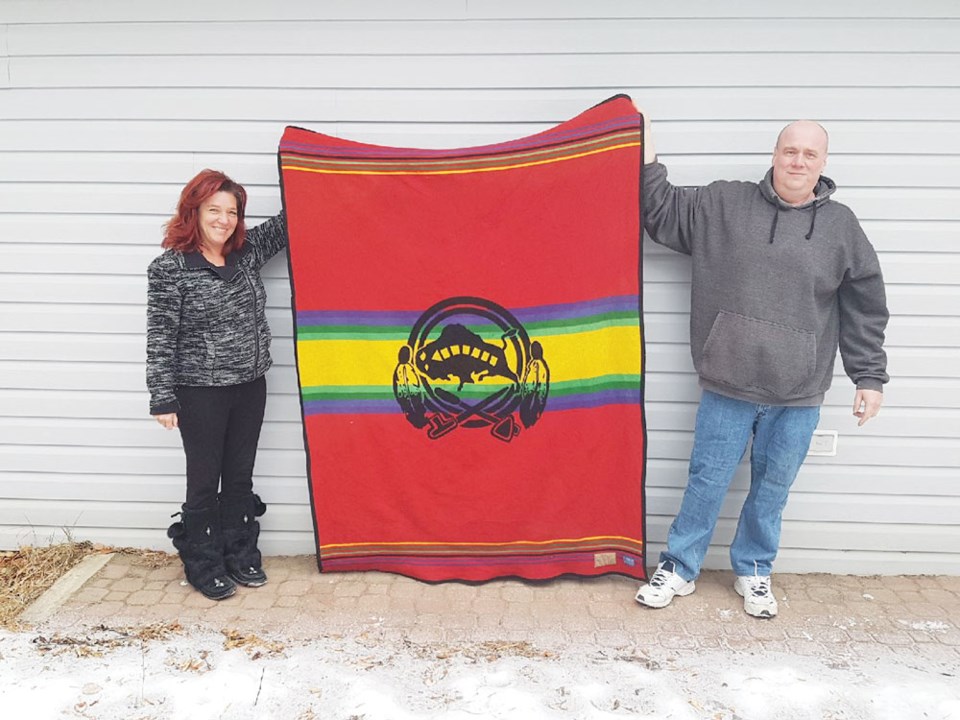Clinton Messer and Tracy Beaulieu were out one day, looking for stray dogs at a local dump in the Carlyle area, and they anticipated on saving a few canines, but instead ended up saving a piece of history.
“I started a dog kennel business, Taj Ma Paws, because of my love of dogs. Once a week I search the local dumps for stray dogs,” said Beaulieu.
“There are a few people like myself that help with rescuing dogs in that area, and once we get them, we feed them and we work with a few adoption places to find them new homes. On one of the days that I go out looking for dogs, Clinton came with me and we came across the blanket, it really stood out to me.”
“We went over out of curiosity and picked it up and realized what it was, and thought this is a really nice thing and doesn’t belong in a dump,” added Messer. “It was obvious when we pulled up the blanket that it had beautiful vibrant colours and it was half hanging out of a garbage bag. We could see it from a long ways away because of the colours.”
The Siksika Nation coat of arms blanket, also referred to as a presentation blanket, was a gift from Ray Hnatyshyn, the former governor general of Canada, on Oct. 13, 1990, to the Siksika Nation.
The blanket’s most prominent colours are red and black with a yellow strip. The blanket also features other very vibrant colours and it is made from 100 per cent wool.
This blanket, at some point, went from being a part of an official ceremony and being handled with great care, to being at the bottom of a garbage bag exposed to elements in a dump.
Hnatyshyn was born in Saskatchewan and he was first elected to the House of Commons in as a member of Parliament in 1974. He took over for Jeanne Sauvé as the 24th governor general of Canada in 1990 when Sauvé’s tenure came to an end.
He is best known for opening Rideau Hall to the public and contributing to the creation of a statue honouring Ukrainian Canadians.
His association with the Siksika Nation and the purpose of the blanket is a missing piece of the story that hopefully will also be found one day.
The Siksika Nation is mostly located in Alberta and they have historic ties to the Black Foot tribe. In recent history they have been a part of the Idle No More movement and have had various land disputes with the federal government.
Beaulieu has been rescuing dogs for about seven years and it started when she found her first dog at the same dump where the blanket was located.
“I used to live near the dump and I was running my dogs at the dump one day. I saw briefly what looked like a black garbage bag blow by, but it turned out to be a black dog that was starving to death,” said Beaulieu.
“It was -60 C with the wind-chill that day and I followed her up the hill and found out she was living in a box that was falling apart because it was wet, and then I found three of her puppies. She started growling at me. I then went home and grabbed some food, put her puppies in my truck and she looked at me, and I told her to get in my truck and she did and I still have her.”
The blanket, since being found, has been cleaned and it is now kept safely inside away from the destructive elements of nature.
“When I got home that’s when I saw the patch on it and knew it wasn’t just your ordinary blanket,” said Messer. “It is a presentation blanket, it should not have been found at a dump.”
“There were a couple other blankets in the bag as well but nothing as special as the one I found. The blanket has got a little bit of damage on one side but it is still in great shape. I would gladly give it back to the tribe but I would like a keepsake.”




